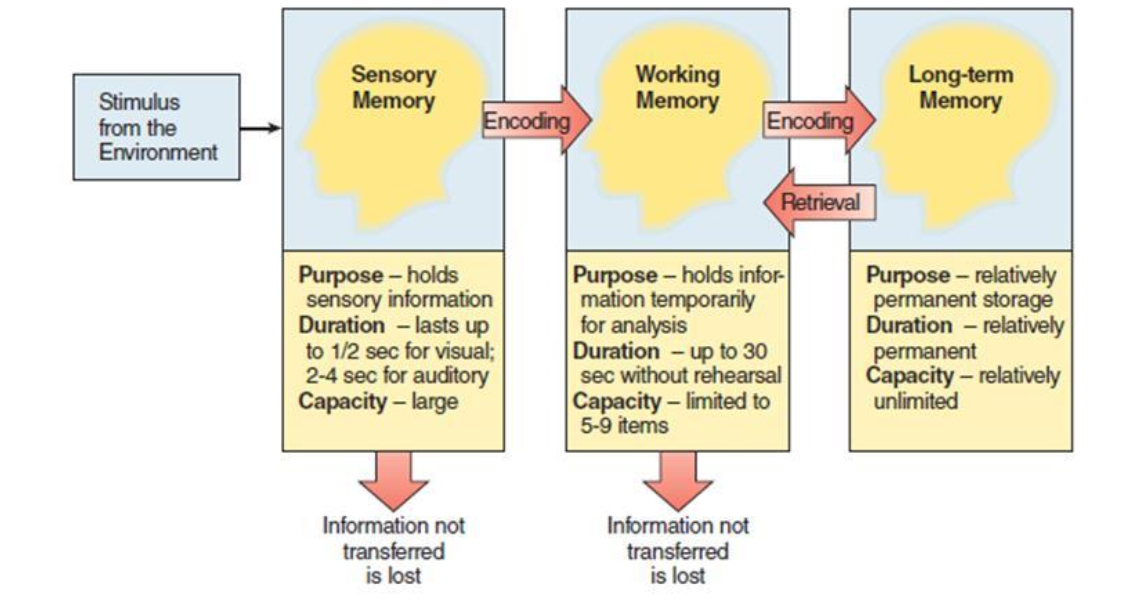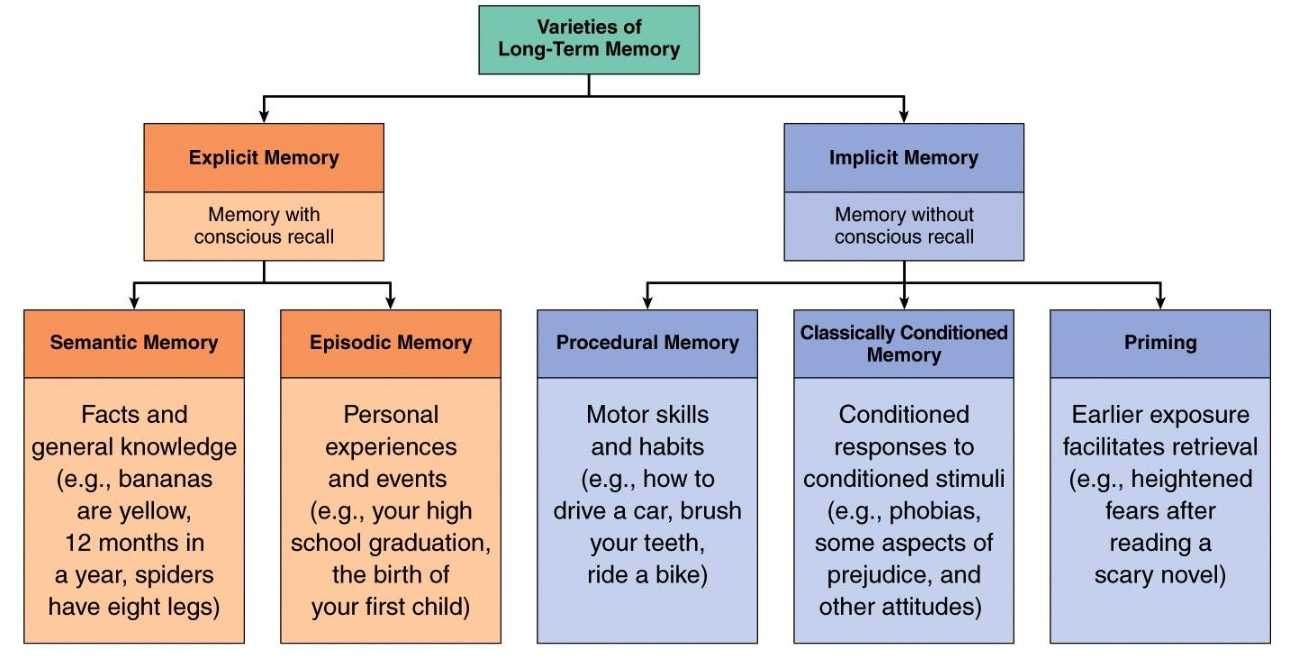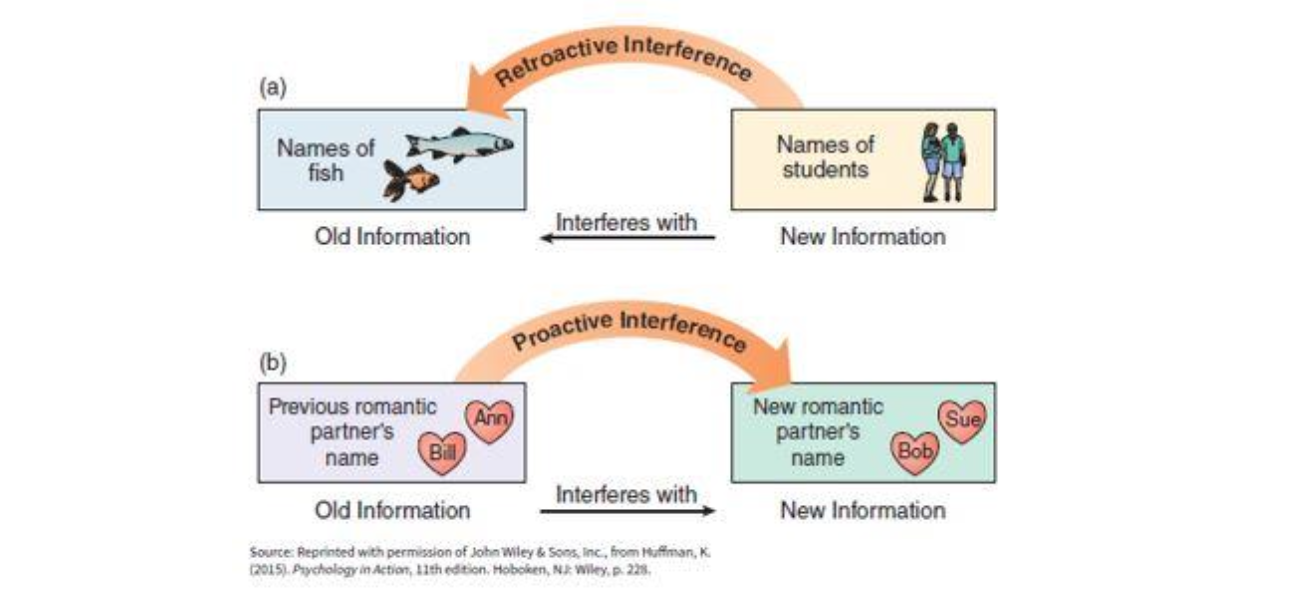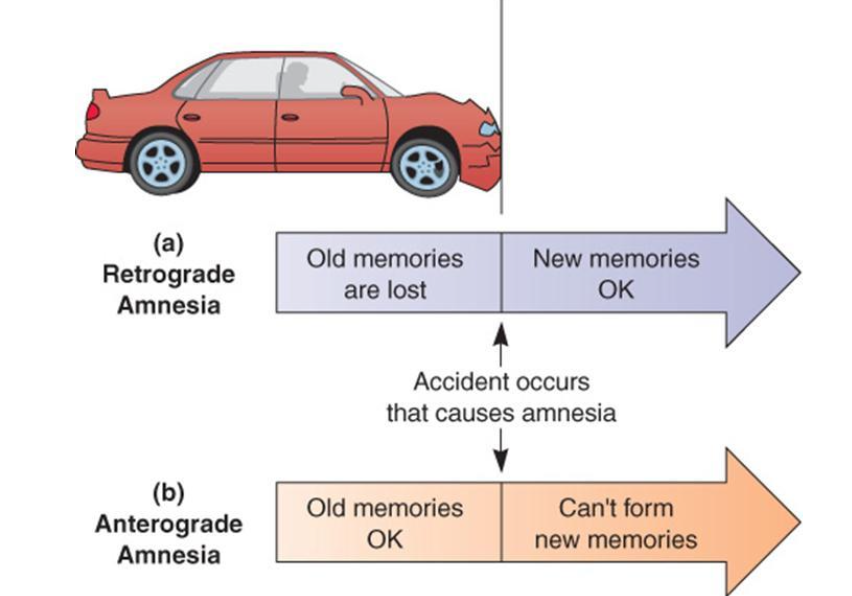Chapter 8
1/47
There's no tags or description
Looks like no tags are added yet.
Name | Mastery | Learn | Test | Matching | Spaced |
|---|
No study sessions yet.
48 Terms
What is memory
Memory is recalling past events and past learning by means of encoding, storage, and retrieval
What are the three processes involved in memory
Encoding - getting information into memory in the first place
Storage - retaining memories for future use
Retrieval - recapturing memories when we need them
What are the two theories of how memory works
Information-Processing Model
Parallel Distributed-Processing Model
What is the information-Processing Model
Information passes through three memory stores during encoding, storage, and retrieval
We are presented with a stimulus and our brain retains a sensory memory of it for less than a second
Sensory memories include: Iconic (what we see) and echoic (what we hear)
What is working (short-term) memory
Holds information for 30 seconds; capacity is 5-9 items
What is the process of the information processing model
Stimulus from the environment
Sensory memory (info is not transferred is lost)
holds sensory info
Lasts up to ½ sec for visual ; 2-4 sec for auditory
Capacity = large
Working memory (information not transferred is lost)
Holds info temporarily for analysis
Up to 30 sec without rehearsal
Limited 5-9 items
Long-term memory
Relatively permanent storage
duration is relatively permanent
capacity is relatively unlimited

What is the parallel distributed-processing model
Information is represented in the brain as a pattern of activation across entire neural networks
Memories are stored in a network of associations throughout our brains
Connectionist
What is the difference between Parallel Distributed & Information processing model
For PDPM memories are stored in a network of associations throughout our brains vs the IPM model of memory that says that material is processed and remembered in stages
What are the three systems within working memory (Baddeley & Hitch)
Central executive : supervisory system that monitors and coordinates the entire working memory system by allocating attentional resources and selectively prioritizing information as it relates to two subsystems
Phonological loop - processes spoken and written information, “little voice” that repeats to keep it as active memory
visuospatial sketchpad - keeps track of images and spatial locations needed for navigation purposes (inner eye)
Third subsystem added: episodic buffer - serves to link together information from the other parts of working memory and creates links to time and order as well as to long-term memory
How do we get information into memory?
To get information into long-term memory, you need to pay attention to it and encode it
Automatic processing - when you remember something without much conscious awareness or effort
Effortful processing - when you remember something with careful attention and conscious effort
When is automatic processing used
Used for remembering matters of time, space, and frequency
e.g. we can remember the path from our front door to our bedroom, we remember where things are in relation to us
When if effortful processing used
Used for a lot of other stuff that we want to remember
E.g. studying for class, remembering someone’s name or phone number
Difference between attention and awareness
To encode anything into memory using either type of processing, we need to pay attention to it
But we are only aware of it in effortful processing
What is sensory memory
Sensory memory involves detailed, brief sensory images or sounds retained for a brief period of time
Photograph viewed for a brief moment
Brief glance at a passing cat
random letters examined fro less than a second
What is working memory
Short-term memory store for information you are thinking about right now, including
Recalled memories, such as phone numbers
what you are reading
How do you transfer sensory memory into working memory
To transfer it into working memory, you must pay attention to the information.
Once in working memory, information can be actively used and rehearsed (e.g., repeating a phone number)
Without attention, sensory information fades almost instantly
What is long-term memory
All of the information we have gathered that is available for use, such as acquired skills, people we know, and past feelings
What is the spaced practice effect
Facilitates moving working memories into long-term memory by rehearsing over time
e.g. don’t cram study
How do you transfer working memory into long-term memory (possibly rework)
Encoding is required to move information from working memory into long-term storage.
Strategies that help:
Rehearsal – consciously repeating information.
Spaced Practice Effect – studying over time strengthens memory better than cramming.
Meaningful encoding – understanding, elaborating, and connecting new info to existing knowledge.
Mnemonics, chunking, schemas, PQRST method – all enhance encoding.
What are the type of encoding
Phonological - encoding based on sound
Visual - encoding based on how the information looks
People with amazing visual encoding skills have eidetic (photographic) memory
Semantic - encoding based on the meaning of the information
What are the best methods of effortful encoding
Understand - we remember things better when we can understand what it means
Elaborate - the more we can elaborate (or expand) on the meaning and make the information personally relevant, the better we remember it
Mnemonic devices - techniques used to increase meaningfulness of information to make it more memorable
Chunking - group bits of information together
e.g. remembering phone numbers
Schemas - organize new information according to the categories created by previous experience and learning
PQRST
What is the PQRST method
Preview - skim if first, identify key themes
Question - turn each subsection into a question that you’ll answer as you read
Read - try to answer the questions you posed yourself
Self-Recitation - ask and answer questions aloud to yourself
Test - practice recalling information from what you read
What are the storage limits of memory
Once information enters working memory it can be stored for only a limited period of time (30 sec.)
Either passed on to long-term or is lost
Memory span= max number of items that can be recalled in the correct order
What are the types of long-term memories
Explicit memory - memory that a person can consciously bring to mind
e.g. home address or date of birth
Implicit memory - memory that a person is not consciously aware of, such as learned motor behaviours, skills, and habits
e.g. riding a bike
What are the types of explicit memories
Semantic
Memory of general knowledge of the world
Episodic
Memory of personal events or episodes from one’s life
Types of implicit memory
Procedural memory
Motor skills and habits
Classically conditioned memory
Conditioned responses like fear, disgust, excitement, etc.
Priming
Exposure to something in your environment that makes a memory more accessible (e.g. seeing an ad reminding)
Types of long-term memories
Explicit memory
Semantic - Facts and general knowledge
Episodic - Personal experiences and events
Implicit memory
Procedural - Motor skills and habits
Classically conditioned - Conditioned responses to conditioned stimuli
Priming - Earlier exposure facilitates retrieval

How are long-term memories organized
Not fully understood
Regardless of their precise organization pieces of information stored in long-term memory are linked to each other, forming a vast network of interwoven associations
How do we retrieve memories
Mentally search brain for stored information
If it is located then it is brought back into working memory
What is serial position effect
Demonstrates two basic retrieval effects
Primacy effect - more likely to remember things heard first
Happens when asked after a delay
Recency effect - more likely to remember things heard most recently
Happens when asked soon after learning
What helps retrieval
Retrieval cues - words, sights or other stimuli that remind us if the information we need to retrieve from our memory
Context effects - we can remember things between where we first learned them
Encoding specificity - the original context (location or situation), mood, or state in which we learn materials is loaded with retrieval cues which leads to memories of the original event
Priming - one piece of information helps us retrieve other related memories
Recognition vs Recall
Recognition: Identifying information when given cues (e.g., multiple-choice test).
Easier because of priming.
Recall: Retrieving information without cues (e.g., essay test, free response).
Harder because it requires active search of memory.
What is state dependent memory
Remembering things better when you are in the same state of mind you were in when you first learned it
Similar to context dependent memory but different
What is Flashbulb memories
Detailed memories of an emotionally significant event, or of the circumstances surrounding the moment we learned about the event
e.g. whereabouts on 9/11 if you were old enough to live through that day
Not more accurate than any other memory
What is forgetting
The inability to recall information that was previously encoded into memory
May be due to failure of attention or lack of retrieval cues
What are the three possible reasons for retrieval failure
Decay theory
Interference theory
Motivated forgetting
What is the decay theory
Memory traces (physical traces in brain) fade over time if they are not used
Forgetting curve - we forget a great deal very rapidly, but the forgetting levels off and the amount of information we retain stabilizes
What is interference theory
Forgetting is influenced by what happens to people before or after they take information in
Proactive interference - competing information that is learned before the forgotten material, preventing its subsequent recall
Old info interferes with new
Retroactive interference - learning of new information disrupts access to previously recalled information
New info interferes with old

What is motivated forgetting
We may forget information that is unpleasant, embarrassing or painful
Repression - process in which we unconsciously prevent some traumatic events from entering our awareness so that we do not have to experience the anxiety or blows to our self-concept that the memories would bring
What are the three factors that contribute to memory distortions
Source misattributions - remembering information, but not its source may lead to remembering information from unreliable sources as true
Imagination - memories can be distorted by false information that comes from within
Misinformation - exposure to new information, particularly misinformation, can also lead to the distortion or the manufacture of false memories
What could cause distorted or manufactured memories (maybe remove)
Hypnosis in therapy, law enforcement, and other contexts has been shown to cause people to distort or manufacture memories, rather than rediscover them
What area of the brain is responsible for memory
No specific memory region
Prefrontal cortex - important in working memory
Hippocampus - important for the transfer of memories into long-term memory
What brain mechanisms are involved in memory consolidation
Memory consolidation – process by which memories stabilize in the brain.
Potentiation – synchronous networks of neurons firing together.
Neural circuits – pathways of connected neurons that strengthen with repeated use.
Long-Term Potentiation (LTP) – repeated stimulation of certain neurons increases the likelihood they will fire strongly in the future.
How does memory and age work
Before age 4 we have memories of faces, places and skills but not memories of life events
Hippocampus develops slowly
Most early episodic memories are emotional
Some types of memory decline with age, starting in our 20s
Prospective (ability to remember future content) & retrospective (ability to remember content from the past)
What is an organic memory disorders
Caused by brain injuries or medical conditions these injuries or conditions damage one or more of the brain regions or brain chemicals that are important in the formation, storage, or retrieval of memories
Most common kinds are amnestic disorders and Dementias
What are the different types of amnestic disorders
Anterograde amnesia - can’t form new memories
Retrograde amnesia - can’t remember things before amnesia-inducing event
Who am I?

What is Dementia
Severe memory problems combined with losses in at least one other cognitive function, such as abstract thinking or language
Alzheimer’s is the most common
What causes Alzheimer’s
Both senile plaques (protein fragments that accumulate between neurons) and neurofibrillary tangles (insoluble fibres that twist together) are thought to damage neurons in the brains of Alzheimer’s patients (both shown on the left).
Plaques and tangles are absent in the healthy brain (right).